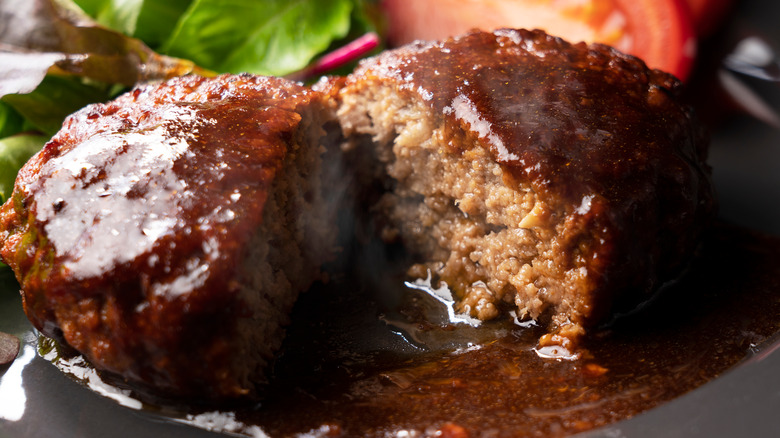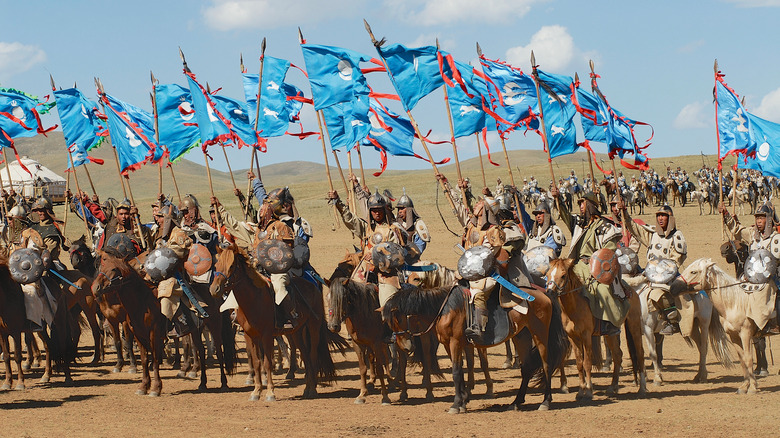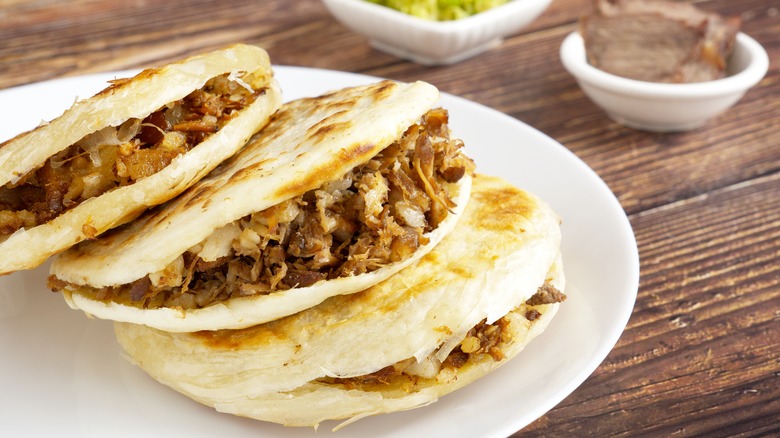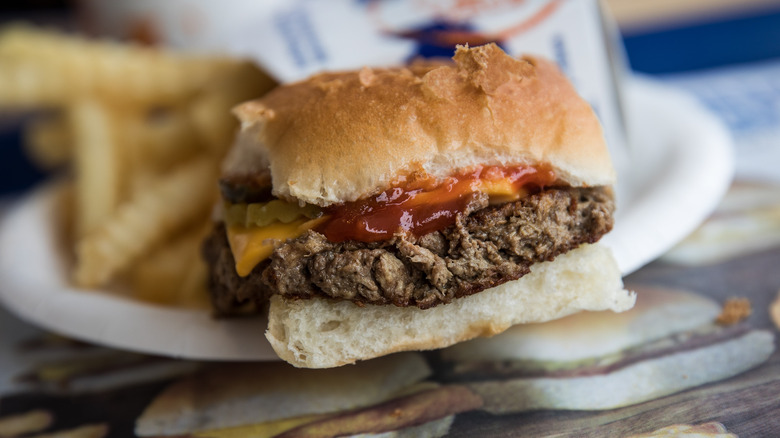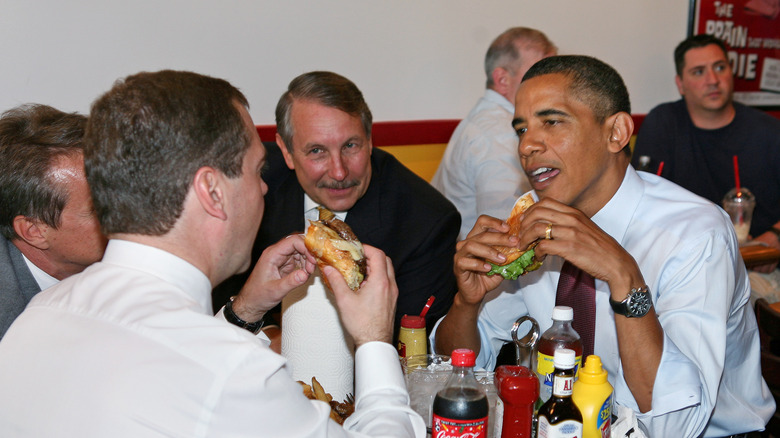What Everyone Gets Wrong About The History Of Burgers
We may receive a commission on purchases made from links.
Burgers are, without a doubt, one of the most popular foods in the United States — if not the world — but how much does the average burger fan really know about this near-ubiquitous sandwich? The history of the hamburger is a juicy, messy tapestry, woven from threads linking disparate places and times, coming together in the 20th century in the form of a food that has transcended boundaries, generations, and definitions.
Just as there is no designated federal language, the United States has no official national food — however, the American obsession with hamburgers has been ongoing for almost 120 years. As the traditional story goes, the hamburger seems to have burst into the American psyche at the St. Louis World's Fair of 1904. But exactly how it came to be there is heavily disputed. Per experts from McDonald's Hamburger University, it was "Uncle Fletch" from Athens, Texas who brought his beef sandwiches to Missouri and kicked the craze off. However, that's really just the tip of the iceberg and the real story involves far more people and goes much deeper.
Have you ever stopped to think about the history of the humble hamburger? Have you ever fallen victim to one of the many myths and misunderstandings that make up burger folklore? From its ancient connections to the quick-service business that developed it into a fast food mainstay, we're here to bust up some of the most persistent misconceptions about the history of hamburgers.
The hamburger's heritage officially dates back to Texas in the 1880s
Though the Texan roots of the burger have been verified by the highest authorities possible, the history of this iconic fast food goes back much further. Hamburger steaks, chopped beef and onions formed into a patty and served on a plate, were available around America in the 1870s.
Competing "world's first hamburger" stories begin to crop up between 1880 and the World's Fair in 1904, but few stand up to scrutiny. The Connecticut claim is outdated by a Texan newspaper clipping from years earlier, and when Uncle Fletch's family produced World's Fair vendor's tickets to prove he was the original hamburger seller, the tickets said he sold ceramics, not sandwiches. The idea that this was an error becomes harder to believe when you hear that Fletch was a potter by trade, and, after allegedly making food history at the World's Fair, he never cooked professionally again — other than in a kiln.
What's not debatable is that ground beef was considered a health food at the time, thanks to Dr. James Salisbury, namesake of Salisbury Steak. Dietary diseases killed more men than combat during the Civil War, so Salisbury investigated the perfect diet. He concluded that soldiers needed more meat and that it ought to be pre-chopped to ease digestion. Those patties are documented, discussed, and dated, but because there's no bread involved, they're left out of burger discussions.
Migrants, rather than a city, may have given the burger its name
One of the ways food historians trace the story of a dish is to follow its name backward through time. The town of Hamburg, in upstate New York, relies on this impulse to lay claim to the hamburger, which they say was first made at the Erie Country Fair in Hamburg, NY in 1885. However, there is another Hamburg with a compelling counternarrative.
The city of Hamburg, Germany, has been an important trading center for almost 1,000 years. By the middle of the 1800s, it was Germany's most important port economically, and if you were in Central or Eastern Europe and wanted to make it to America, Hamburg was your gateway to the New World . Before this, in a 1747 English cookbook, a recipe for "Hamburgh sausage" shows the city was associated culinarily with beef — the recipe called for ground and smoked beef spiced with nutmeg and served with toasted bread.
This long-standing connection gives credence to reports that migrants passing through the city would have encountered and been comforted by bread rolls full of hot beef, both on the streets of Hamburg and on the decks of the Hamburg-America Line ships. It also links the burger with the American dreams of those migrants, as well as their memories of leaving home, which potentially explains why the "Hamburger" branding resonated with so many.
Many credit the armies of Genghis Khan with inventing the burger
The Mongolian armies of Genghis Khan conquered much of the known world by horseback. Their homelands were harsh, huge, and hard to hunt; their reputation as barbarians was second to none; and their association with horseback riding endures in modern times. So it would seem almost reasonable that these horselords are said to have survived by placing slices of horsemeat beneath their saddles each day to store, tenderize, and cook the precious protein. This technique is supposedly the origin of both steak tartare and hamburgers, but the evidence to support this tale is weak.
We can believe that Mongol army rations would have been bleak. It's much harder to believe that just because they were scary, these horse warriors could somehow stomach severe food poisoning. They would quickly have realized that keeping a steak between a saddle and a horse doesn't slow cook it, it just soaks it in sweat and keeps it at the perfect temperature for bacteria to grow, rendering the meat unsafe to eat.
However, this still overlooks the point that cavalrymen cooking steak by saddle each day makes about as much sense as an infantryman cooking a potato by putting one in their boots as they march. Food safety issues notwithstanding, badly fitting saddles cause a host of issues for horses on short rides, let alone cross-continental conquests! There are simply too many downsides to this technique to believe the burger began this way.
Ancient recipe books have been found to contain burgers
Despite being separated by millennia, there are many obvious parallels between Ancient Rome and the United States. Not least because many aspects of the U.S. Constitution were based on the way the Roman Republic was run. But few people realize that the Romans also had their version of fast-food restaurants (called "thermopolia"), as well as recipes for ancient burgers.
"De Re Coquinaria" is the oldest collection of recipes to survive from Roman times. The title means "The Art of Cooking," though many refer to the book by the name "Apicius," who was supposedly the author — though he died centuries before the book was compiled. Nevertheless, his reputation as a gourmand has lasted 2,000 years, and in the book that bears his name, historians have found what many consider to be the first burger recipe. Known in Latin as Isicia Omentata, these patties were made of ground meat, made richer with pine nuts, spices, and flavored with wine and garum— Rome's favorite condiment, which roughly resembled modern Thai fish sauce.
If the idea of a red wine-enriched burger makes your mouth water, there are more modern methods to get booze into your bun. No less an American culinary icon than Julia Child recommended making a rich bone marrow and red wine sauce to take her burgers to the next level, and for a quicker version, Amy Traverso made a red wine aioli in homage to Julia.
There is an ancient Asian origin story for the burger
The earliest and most Eastern claim on the invention of the hamburger comes from the city of Xi'an in Shaanxi province, China. This ancient metropolis is one of the historical capitals of Imperial China. It is home to the world-famous terracotta army, and was the end of the ancient Silk Road trading route that spanned the deserts and mountains of Central Asia to connect China with Europe and the Arab world. It's also the home of the street food snack that many have dubbed the "Chinese hamburger" — Rou Jia Mo (肉夹馍).
The literal translation means "meat in a bun", and that is exactly what you should expect! These chewy, pan-grilled buns are split in half and stuffed with a heavily seasoned mixture of chopped meat. Pork is the most popular filling in China these days, but thanks to the Silk Road and the long history of Muslim influence along its route, beef has also often been a common option in Shaanxi. People have been making the bread for roujiamo since the Qin dynasty, and the meat filling has an even longer history, so although nobody can lay claim to inventing the dish, historians are comfortable dating it as far back as 221-206 BCE!
McDonald's isn't the original American burger chain
At the 1904 World's Fair in St Louis, the burger was introduced to a mass audience, alongside other novelties like Dr. Pepper, puffed rice, and the ice cream cone. But there would be one more stumbling block before the hamburger could claim world domination — reputation.
Just a few months after the World's Fair gave hamburgers their big break, public demand for ground beef products fell off a cliff, thanks to "The Jungle" by Upton Sinclair, released in 1905. Sinclair hoped to spark a conversation about the plight of immigrant workers and the devastating conditions that they were forced into — however, what sparked a reaction from the public were his stomach-churning callouts of what the meatpacking industry was serving to the public and calling "ground beef." The outrage was sufficient to move Congress to pass food safety laws by June 1906,though this didn't save ground beef from a reputation as practically poisonous.
One man managed to turn the narrative around though. Edgar Waldo "Billy" Ingram, the founder of White Castle, saw an opportunity in the burger business and built their whole brand around hygiene and quality control. White tiles, clean kitchens, and near-identical burgers in each location were their hallmarks and made White Castle the first-ever fast-food chain. Thanks to clever advertising and the consistent message of safety and quality, Ingram managed to rehabilitate the image of the burger, as well as reinvent the restaurant for the 20th century.
Burger chains went nationwide thanks to suburbs and the new highway network
White Castle may have been the first fast-food chain, but it certainly wasn't the last. Most of the big names in burgers began their businesses in the years immediately following World War II. America was in the ascendancy, an industrial, modern nation, fueled by industrial, modern foods that were also delicious.
The rise of the chains was catalyzed by the Federal Highway Act of 1956, which fundamentally changed how American people worked and traveled. The cross-continental sprawl of highways across America meant that chains could provide the same quintessential American comfort food for mere cents — hamburgers — to a trucker a thousand miles from home in Oregon, a kid at their birthday party in suburban Illinois, and teenagers going to the beach on a date in Florida. Shared food customs are a fundamental part of nation-building, and a deep association formed between burgers and car culture at the heart of '50s Americana.
It wasn't just that burgers were convenient, tasty, and cheap — as America built more and more roads, commuting to work became a much more attractive prospect, and the suburban building boom began. These new neighborhoods were leafy, spacious, and modern, but lacked the facilities and infrastructure, that older, more established towns had. Fast food franchises stepped into the gap that was left when developers built suburbs with no restaurants or grocery stores, and now several generations of Americans have grown up on suburban McDonalds'.
The drive-thru was invented later than you'd expect
In 1954, Ray Kroc visited a restaurant run by two brothers in San Bernadino, California. After seeing crowds queuing up ahead of the opening, and the efficiency of their burger assembly line system, he convinced the McDonald's to franchise their business. He said in his autobiography that on that day he "felt like some latter-day Newton who'd just had an Idaho potato caromed off his skull ... Visions of McDonalds' restaurants dotting crossroads all over the country paraded through my brain." There are now over 38,000 McDonalds' restaurants in 100 countries.
Franchising allowed McDonald's to innovate — items like the Egg McMuffin and the Big Mac were the brainwaves of individual owners that hit the big time. However, the most iconic technical innovation in burger-slinging wasn't a McDonald's idea at all. In 1971, Wendy's changed fast food culture forever by adding the "pick up window" — aka the first modern drive-thru.
Although eating burgers in your car was normal enough, until the '70s people would park and walk up to the counter to order. Sometimes car hops — parking lot waiters — would take your order and then bring your food to you, but that era mostly ended with the drive-thru. The convenience of never leaving the seat of your car turbocharged Wendy's success, and now drive-thru service has spread to coffee, pizza, and even wedding chapels. Now, over 70% of McDonald's U.S. business is conducted via the drive-thru window.
The 21st-century burger is a part of American geopolitics
After the collapse of the USSR in the 1990s, it seemed as if the forces of American globalization were ushering in a new boom time that merged '50s nostalgia with the global technology of the 20th century. The perfect metaphor for this was the humble burger. The memories evoked by eating a hamburger linked it to the halcyon past. Constant promotional tie-ins with the latest movies, bright colors, and new jingles allowed burger chains to stay relevant to newer generations worldwide.
On January 31, 1990, the first McDonald's opened in Moscow. Over 30,000 Muscovites visited that day, even though a Big Mac cost about the same as a month's metro pass. Those burgers were such a symbol of how things were changing for ordinary Russians that many people took home the packaging as a souvenir, and long queues for burgers weren't uncommon for several years afterward.
It's not just novelty. Vietnam had fast food chains in the decades before McDonald's opened in 2014, almost 40 years after the fall of Saigon. Yet hundreds of customers queued up on the opening day, getting entertained by musicians and being interviewed by the international media. Geopolitics is a two-sided coin, though. As much as a new McDonald's symbolized a hopeful future for U.S.-Russia relations, when the chain was forced to close its Russian arm in 2022, it was a powerful symbol to ordinary Russians that the relationship had shifted for the worse.
Burgers owe their popularity to travel more than any individual brand or inventor
There's a temptation to focus on one diner owner, one family, or one town as if telling their tale will reveal something interesting underlying about hot beef sandwiches. Rather than debating who put meat on bread first, it is perhaps better to think about how, as Freakonomics pointed out, the fast food cheeseburger might be the best food in human history. Instead of worrying about where can claim to be the home of the hamburger, should we consider the question of why this combination of ground meat and bread has had such historic success?
From Xi'an at the end of the Silk Road, to San Bernadino at the end of Route 66, burgers have been a road food. From the docks of Hamburg to the fall of the USSR, burgers have given comfort to hungry crowds who were uncertain of their future.
Whether Ray Kroc, Billy Ingram, or some other businessman led the drive to streamline and standardize restaurant workflows, it was always the customers whose worries, stresses, and triumphs truly made the burger an American success story. We crave the freedom of the open road, and we crave the comforts of home. The burger brings us both.

